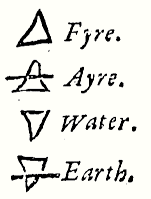Quinta Essentia
August 7, 2009 at 8:57 pm (Alchemy, Enlightenment, Exclusive Societies, Geology, India, Japan, Kabbalah, Literature, Metallurgy, Mythology, Religion, Shakespeare, Symbology, Technology, The Ancient World, The Occult, The Renaissance, Theater) (4 elements, alchemical symbols, Alchemy, classical elements, fifth element, four elements, history of chemistry, irrational geographic, quinta essentia, quintessence, quintessence of dust, what a piece of work is man)
“What a piece of work is man. How noble in reason, how infinite in faculties. In form and moving, how express and admirable. In action how like an angel. In apprehension, how like a god. The beauty of the world, the paragon of animals. And yet, to me, what is this quintessence of dust?”
– The Tragedy of Hamlet, Prince of Denmark, Act II, scene ii

Shakespeare's tortured prince weighing the value of mankind.
This dizzyingly rich quotation is familiar to any student of literature, and has become a sort of mantra to those who practice the theatrical art of soliloquy. But what interests me here are not the layers upon layers of meaning that Shakespeare wove using these words, but rather one individual word in particular. That word is quintessence which, as it is used in this context, is defined by the Oxford English Dictionary as “The most typical example of a category or class; the most perfect embodiment of a certain type of person or thing.” But a bit of etymological reasoning leads to more questions than answers. Why would the prefix quint, meaning five, when attached quite literally to the word essence, produce a word synonymous with archetype or apotheosis? What is this mysterious fifth essence that has seemingly sneaked unnoticed into our contemporary lexicon? The answer, it turns out, lies in various ancient philosophies, ranging from the ancient Greeks to the age-old practice of alchemy.

A table of Medieval alchemical symbols.
The practice of alchemy, which combines elements scientific, philosophical, and spiritual, is believed to date back to traditions of the ancient Persian Empire, as early as the 8th century BC. While certain aspects of alchemy bear resemblance to complex spiritual systems such as Kabbalah, its more practical attributes can be seen as a precursor to modern chemistry. Although alchemists practicing in different eras and parts of the world embraced drastically differing systems, one unifying theme running through them all is a concern with physical elements.

The four primary, or Classical, elements are earth, air, fire, and water. This way of dividing the physical world can be found in various ancient cultures. In many traditions, however, there is a fifth element that is considered to be the most important one of all. Known to the Greeks as Aether, the Hindus as Akasha, and the Japanese as void or sky, the notion of a fifth, ethereal element that ties the four physical elements together is pervasive amongst ancient philosophical traditions. It is from the alchemical interpretation of this fifth element, this quinta essentia, that we receive our term signifying an example of perfection. Sometimes referred to as the Philosopher’s Stone, the fifth element is the unity that comes with the mastery of the four lower elements, a whole greater than the sum of its parts. It is just this notion that Shakespeare was evoking when he dubbed man “the quintessence of dust”. After all, even a ghost in the machine, no matter how powerful the spirit and how complex the mechanism, is still a mere ghost in a mere machine. This conclusion was, it seems, one of the weights that made Prince Hamlet’s head so heavy.
Some Further Reading:
The online text of a University of Virginia class focusing on the history of alchemy
An analysis of Hamlet’s “What a piece of work is man…” soliloquy
The entry for lapis philosophorum (the Philosopher’s Stone) from Symbols.com
A site that catalogues the history of chemistry, from alchemy to nanotechnology